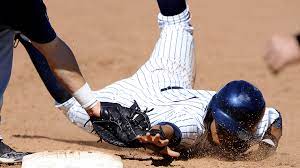- Time To the plate
How long it takes to deliver the pitch is arguably the most important aspect to controlling the running game and shutting down base stealers. To measure a pitcher’s time to the plate, start the timer when the pitcher begins his delivery and stop it once the ball hits the catcher’s glove. The time to the plate will depend on a few things including: lefty vs righty pitcher, leg lift vs slide step, pitch speed/type.
To elaborate:
Lefty vs Righty: Lefties tend to be slower to the plate as they can lift their leg and still pick over to first base.
Leg lift vs slide step: A slide step is simply just a stride towards home with zero leg lift, making it much quicker whereas a leg lift will take more time to develop.
Pitch speed/type: A fastball traveling at 98mph will get to home plate faster than a fastball traveling 90mph. Same goes for offspeed pitches (changeups or curve/slider) as they will take longer to get to the plate, thus giving the baserunner more time to reach his intended base.
So what is a good time to the plate? According to Baseball America “A pitcher with a quick sidestep can get the ball home in 1.1-1.2 seconds. Without the slide step, most teams want to see their pitchers clocking in at 1.3 seconds. A slow pitcher will take as much as 1.5 to 1.6 seconds.” You can easily get a pitcher’s time from the dugout, so if you have a stopwatch or even a phone handy, anything 1.4 or greater is prime stealing territory!
- Mix Up Your Looks and Holds
Bases are stolen off the pitcher. Sure, having a good pop time as a catcher is helpful, but ultimately the pitcher determines the outcome most of the time. This is where it is so important to mix up looks and hold times as a pitcher. But what do we mean by this? If you are coming set for one second every single time and looking once at the runner, it will become easy to pick up on patterns of when you will deliver the pitch.
How to be effective with your looks and holds is doing something different every pitch. For this example we will assume a runner is on second base. Maybe the first pitch you come set while looking at the runner and hold there for a few seconds before delivering the pitch. Your next pitch may look something like coming set looking at home plate, giving the runner a quick look, then delivering. The third time might look something like coming set looking at home, taking a look at the runner then back to home before taking a second look at the runner before delivering the pitch. Catch our drift? Be unpredictable!
- Pick Offs
Picking off is a crucial aspect to keeping baserunners at bay. Runners will not be scared to steal if they know you will not throw over, so make them think a little! Using this in combination with a quick time to the plate and mixing looks and holds will make it extremely tough to run on you as an opposing baserunner. Sometimes you don’t even need to throw over to the base, a simple step off the rubber may do the trick as well.
When you get to more advanced levels, you will develop two maybe three different types of pick off moves to each base. You will have a standard non-threatening “I know you are there” type of move. Then you will develop a legitimate “I want to pick you off move.” The difference here is the speed at which you disengage the rubber and the speed of your throw. Practice both moves often and get really confident with them. Confidence is key while doing anything baseball related and confidence comes from practice. If you don’t have anyone to practice with, tape a square onto the wall to throw to, no excuses!
